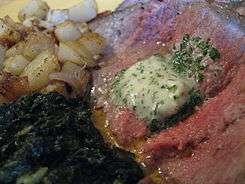Compound butter
Compound butters (French: beurre composé, pl. beurres composés) are mixtures of butter and supplementary ingredients. Primarily, they are used to enhance flavor in various dishes, in a fashion similar to a sauce.[1][2][3]

A New York strip steak topped with Beurre Maitre d'Hotel, served with potatoes and creamed spinach
%2C_a_traditional_Bavarian_dish_often_served_with_onion_rings%2C_rye_bread%2C_composed_butter_(with_herbs_and_garlic)_and_horseradish.jpg)
Kronfleisch (skirt steak), a traditional Bavarian dish. Served with onion rings, rye bread, compound butter (with herbs and garlic – beurre à la bourguignonne), and horseradish
Compound butters can be made at home or purchased commercially. A compound butter can be made by whipping additional elements, such as herbs, spices or aromatic liquids, into butter. The butter is then reformed, usually in plastic wrap or parchment paper, and chilled until it is firm enough to be sliced. These butters can be melted on top of meats and vegetables, used as a spread or used to finish various sauces.
Warm beurres composés include:
- Beurre blanc
- Beurre au citron – lemon butter
Cold beurres composés include:
- Beurre à la bourguignonne – garlic and parsley butter
- Beurre Maitre d'Hotel, butter with parsley and lemon juice
- Café de Paris butter
References
- Auguste Escoffier (1903), Le Guide culinaire, Editions Flammarion
- Julia Child (1961), Mastering the Art of French Cooking, Alfred A. Knopf
- Larousse Gastronomique (1961), Crown Publishers
(Translated from the French, Librairie Larousse, Paris (1938))
External links

This article is issued from Wikipedia. The text is licensed under Creative Commons - Attribution - Sharealike. Additional terms may apply for the media files.